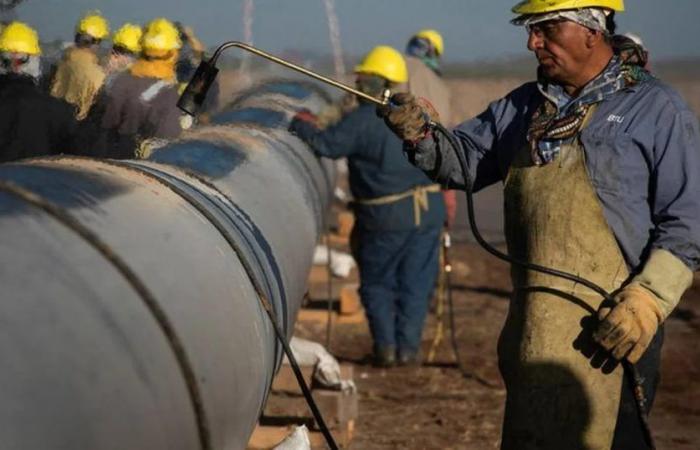
Although it will not be ready for the beginning of winter, the reversal of the “Gasoducto del Norte Argentino (GNA)”, vital for seven provinces in the center and north of Argentina to have sufficient gas supply, both for domestic use and for The generation of electricity in thermal power plants is advancing rapidly, largely thanks to the contribution of the Development Bank of Latin America and the Caribbean, which continues to be identified more as CAF (for Andean Development Corporation), as it was born in 1970, originally formed through Colombia, Venezuela, Ecuador, Peru and Bolivia.
Argentina joined the organization in 2021, which today has 21 associated countries, including two from outside the zone: Spain, which joined in 2002, and Portugal, in 2009.
The Bank lent Argentina USD 540 million for the reversal of the GNA, so that the gas, which previously came from Bolivia and flowed from north to south, can flow in the opposite direction, from south to north, and distribute the growing production “unconventional” gas from Vaca Muerta, from the Neuquén Basin.
Starting in August or September, this gas will replace Bolivia’s declining gas supply, which is now almost unable to cover its own demand. This week the government of Luis Arce militarized the country’s service stations due to the lack of fuel supply and suspicions of black markets and smuggling, the cause and effect of the growing shortage.

The Latin American Bank has become a key credit source for Argentina, which is today, with an accumulated portfolio of USD 5,504 million, its main client, with 16.1% of its credit portfolio, almost four points above the second ( Ecuador, 12.4%) and almost double the third (Brazil, 8.8%).
The reversal of the Gasduct is the only national public work tendered and initiated by the government of Javier Milei and it is the type of works that the entity chaired by the Colombian Sergio Diaz Granadosformer Minister of Commerce, Industry and Tourism of his country, prioritizes the “energy transition” within the framework of his strategy to support it.
Gas is considered in the transition for being a much less polluting hydrocarbon than coal and oil and helps reduce the consumption (and eventually, also the import) of liquid fuels such as diesel and fuel oil. Out of 16 projects listed and identified in South America in the latest CAF annual balance sheet, the reversal of the GNA is marked as number one.
The work, which will provide gas to the provinces of Santiago del Estero, Tucumán, Catamarca, Salta, Jujuy, La Rioja and Córdoba, is progressing under the supervision of the state-owned Enarsa and is being carried out by the Transitory Business Union (UTE) that was formed Techint and Sacde, which also built, at record speed, the first section, between the towns ofTrayen (Neuquén) and Salliqueló (Buenos Aires) of the “President Néstor Kirchner Gasduct” inaugurated on July 9 of last year, although its compressor stations were not completed and mean that for now the Vaca Muerta Gas flows at a maximum of 11 million cubic meters of gas per day, a volume lower than its potential and insufficient to fully cover the gas consumption of the Metropolitan Area in the coldest months. of Buenos Aires (AMBA).

The reversal of the GNA will allow about 16 million cubic meters per day to reach the northern and central provinces, improving coverage of the country’s total gas demand. For the first cold weeks and months of this winter, the gas consumption of these provinces will be supplied, at least in part, with Liquefied Natural Gas (LNG) that arrives in ships to the Mejillones regasification plant, in Chile, and will arrive to Argentina through the Norandino gas pipeline.
The “reversal” – Enarsa stated in a recent statement – already included the regular line welding of sections 2 and 3, the first 100 kilometers of the so-called “Federal Integration Gas Pipeline” – for a total of 122 km – which extends from Tío Pujio to La Carlota, in Córdoba, linking the Central-West and North Gas Pipelines.
The entity explained that to shorten work times, an automatic welding system was used (the same one applied in the GPNK) and that 4,059 welds were already carried out in 41 days, with records of up to 151 welds (about 3 kilometers) per day. . In addition, the company said, “the work is progressing with the construction of the remaining 22 km of the Gas Pipeline, 62 kilometers of loops to the North Gasduct at the height of Ferreyra and the City of Córdoba and the change of direction of 4 compressor plants, with the completion date of the works scheduled for the end of August.”
Techint and Sacde completed those welding, but they have not yet collected them from the national State, which owes them about $14,000 million in May, which was covered with credit from commercial banks.

The total budget for the work is USD 720 million, of which the credit of USD 540 million from the Latin American Bank covers three quarters. The remaining quarter will be covered by an Argentine electricity export fund, although the increase in construction costs in dollars (a recurring problem of the current economic scheme in which the monthly increase pattern of the dollar continues to lag far behind inflation) makes it probable that the final cost in dollars is higher than initially budgeted.
The decline in Bolivian gas sales and the need for the reversal of the GNA is a long-told story. For example, in July 2003, the then Secretary of Energy, Flavia Royón, explained in a resolution the “high risk of shortage of natural gas and electricity to users in the center and north” in 2024, due to the cessation of the Bolivian contribution. But despite having USD 540 million in credit from the Development Bank of Latin America, the Fernández government, although it threatened several times to put out to tender the work, never started it.





